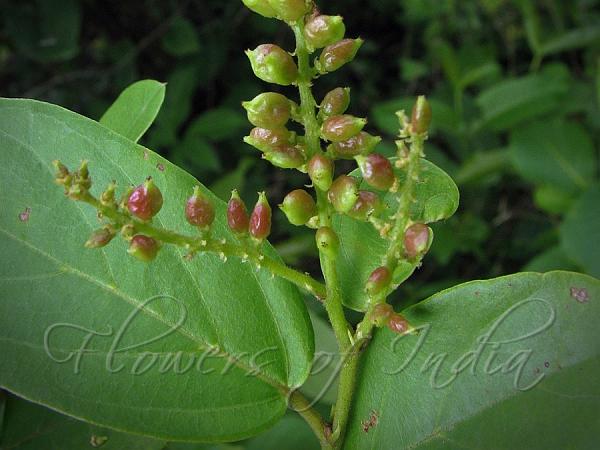|
| Black Currant Tree |
|

|

| File size | 141650 |
| Original date | 7/14/13 9:14 AM |
| Resolution | 900 x 675 |
| Flash | Flash did not fire, auto |
| Focal length | 6.0mm |
| Exposure time | 1/160s |
| Aperture | 5.0 |
| Focus Distance | |
| Metering Mode | Multi-segment |
| Camera make | Canon |
| Camera model | Canon PowerShot S5 IS |
| Sensor type | OneChipColorArea |
|
|
|
|
Photo: |
Botanical name: Antidesma ghaesembilla Family: Phyllanthaceae (Amla family)
Synonyms: Antidesma spicatum, Antidesma pubescens, Antidesma frutescens
Synonyms: Antidesma spicatum, Antidesma pubescens, Antidesma frutescens
Black Currant Tree is a tree, up to 12 m high, bark
grey. Leaves are simple, alternate, stipulate.
Leaf-stalks are 3-25 mm, slender, velvety, blade
2.5-14 x 1.5-10 cm, oblong, oblong-elliptic, obovate, olmost round or
ovate, lateral nerves 3-7 pairs. Flowers are unisexual,
reddish-yellow; male flowers: in terminal and axillary much branched
spikes. Flower-cluster-stalks are densely brown or rusty woolly;
flowers about 1.2 x 1-2 mm, cup-shaped, densely hairy or velvety outside,
tepals 5, ovate, pointed,
stamens 4-5, 1-2 mm long. Female flowers borne in branch-end and in
leaf-axils branched or simple racemes.
Flower-cluster-stalks are densely brown or rusty woolly; flower-stalk
0.8-1.5 mm, flowers cup-shaped, 1-1.5 x 1.5-2 mm,
tepals 5, elliptic, ovate or linear-oblong, almost free,
pointed. Fruit is a drupe 4-6 x 3-5 mm, compressed-round,
hairless, reddish-brown or black, alveolate. Black Currant Tree
is found in Tropical & Subtropical Asia to N. Australia, including the
Himalaya.
| Identification credit: Prashant Awale, Shrikant Ingalhalikar | Photographed in Rivona, Goa & Dalam Wildlife Sanctuary, Jharkhand. |
• Is this flower misidentified? If yes,